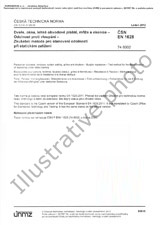We need your consent to use the individual data so that you can see information about your interests, among other things. Click "OK" to give your consent.
ČSN EN ISO 4037-3 (404317)
Radiological protection - X and gamma reference radiation for calibrating dosemeters and doserate meters and for determining their response as a function of photon energy - Part 3: Calibration of area and personal dosemeters and the measurement of their response as a function of energy and angle of incidence
Translate name
STANDARD published on 1.9.2021
The information about the standard:
Designation standards: ČSN EN ISO 4037-3
Classification mark: 404317
Catalog number: 512576
Publication date standards: 1.9.2021
SKU: NS-1034860
The number of pages: 84
Approximate weight : 283 g (0.62 lbs)
Country: Czech technical standard
Category: Technical standards ČSN
The category - similar standards:
Annotation of standard text ČSN EN ISO 4037-3 (404317):
This document specifies additional procedures and data for the calibration of dosemeters and doserate meters used for individual and area monitoring in radiation protection. The general procedure for the calibration and the determination of the response of radiation protection dose(rate)meters is described in ISO 29661 and is followed as far as possible. For this purpose, the photon reference radiation fields with mean energies between 8 keV and 9 MeV, as specified in ISO 4037-1, are used. In Annex D some additional information on reference conditions, required standard test conditions and effects associated with electron ranges are given. For individual monitoring, both whole body and extremity dosemeters are covered and for area monitoring, both portable and installed dose(rate)meters are covered.
Charged particle equilibrium is needed for the reference fields although this is not always established in the workplace fields for which the dosemeter should be calibrated. This is especially true at photon energies without inherent charged particle equilibrium at the reference depth d, which depends on the actual combination of energy and reference depth d. Electrons of energies above 65 keV, 0,75 MeV and 2,1 MeV can just penetrate 0,07 mm, 3 mm and 10 mm of ICRU tissue, respectively, and the radiation qualities with photon energies above these values are considered as radiation qualities without inherent charged particle equilibrium for the quantities defined at these depths. This document also deals with the determination of the response as a function of photon energy and angle of radiation incidence. Such measurements can represent part of a type test in the course of which the effect of further influence quantities on the response is examined.
This document is only applicable for air kerma rates above 1 µGy/h.
This document does not cover the in-situ calibration of fixed installed area dosemeters.
The procedures to be followed for the different types of dosemeters are described. Recommendations are given on the phantom to be used and on the conversion coefficients to be applied. Recommended conversion coefficients are only given for matched reference radiation fields, which are specified in ISO 4037-1:2019, Clauses 4 to 6. ISO 4037-1:2019, Annexes A and B, both informative, include fluorescent radiations, the gamma radiation of the radionuclide 241Am, S-Am, for which detailed published information is not available. ISO 4037-1:2019, Annex C, gives additional X radiation fields, which are specified by the quality index. For all these radiation qualities, conversion coefficients are given in Annexes A to C, but only as a rough estimate as the overall uncertainty of these conversion coefficients in practical reference radiation fields is not known
Preview of the standard ČSN EN ISO 4037-3 (404317)
We recommend:
Technical standards updating
Do you want to make sure you use only the valid technical standards?
We can offer you a solution which will provide you a monthly overview concerning the updating of standards which you use.
Would you like to know more? Look at this page.




 Cookies
Cookies
